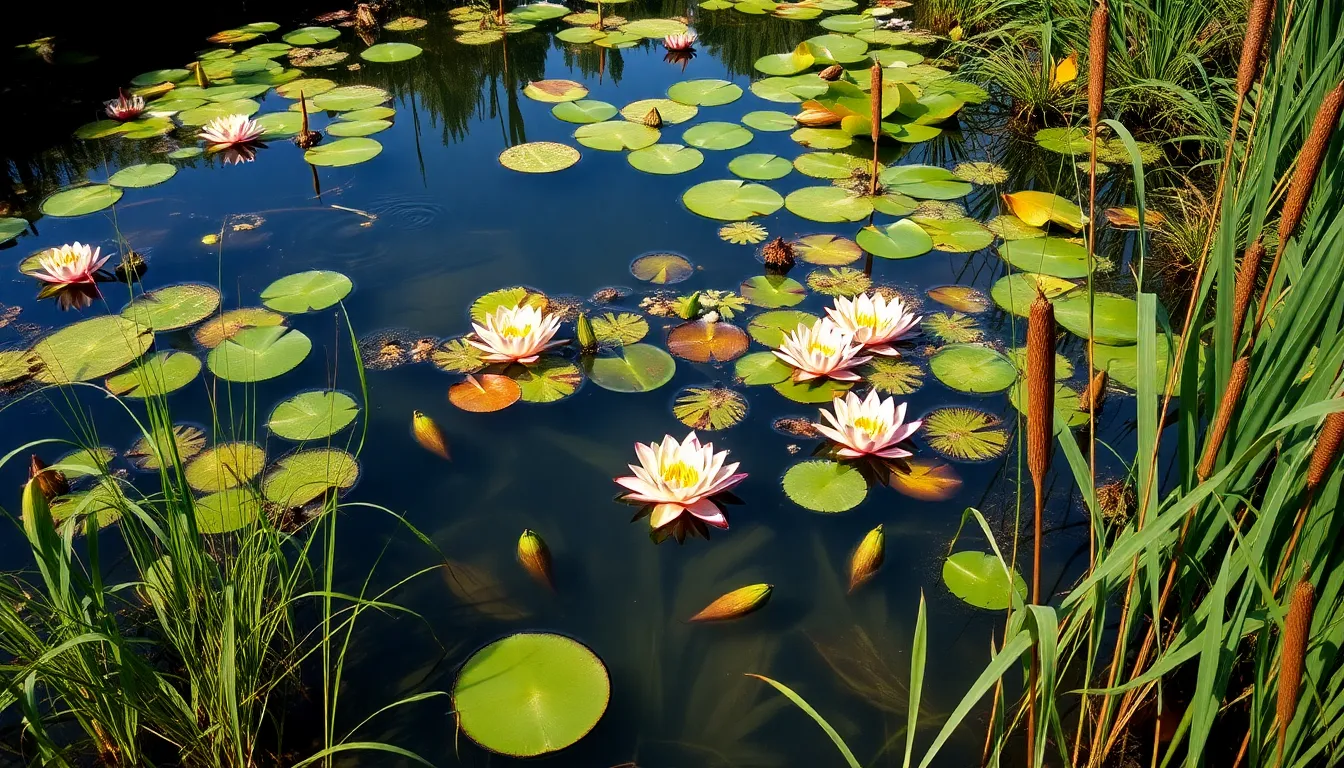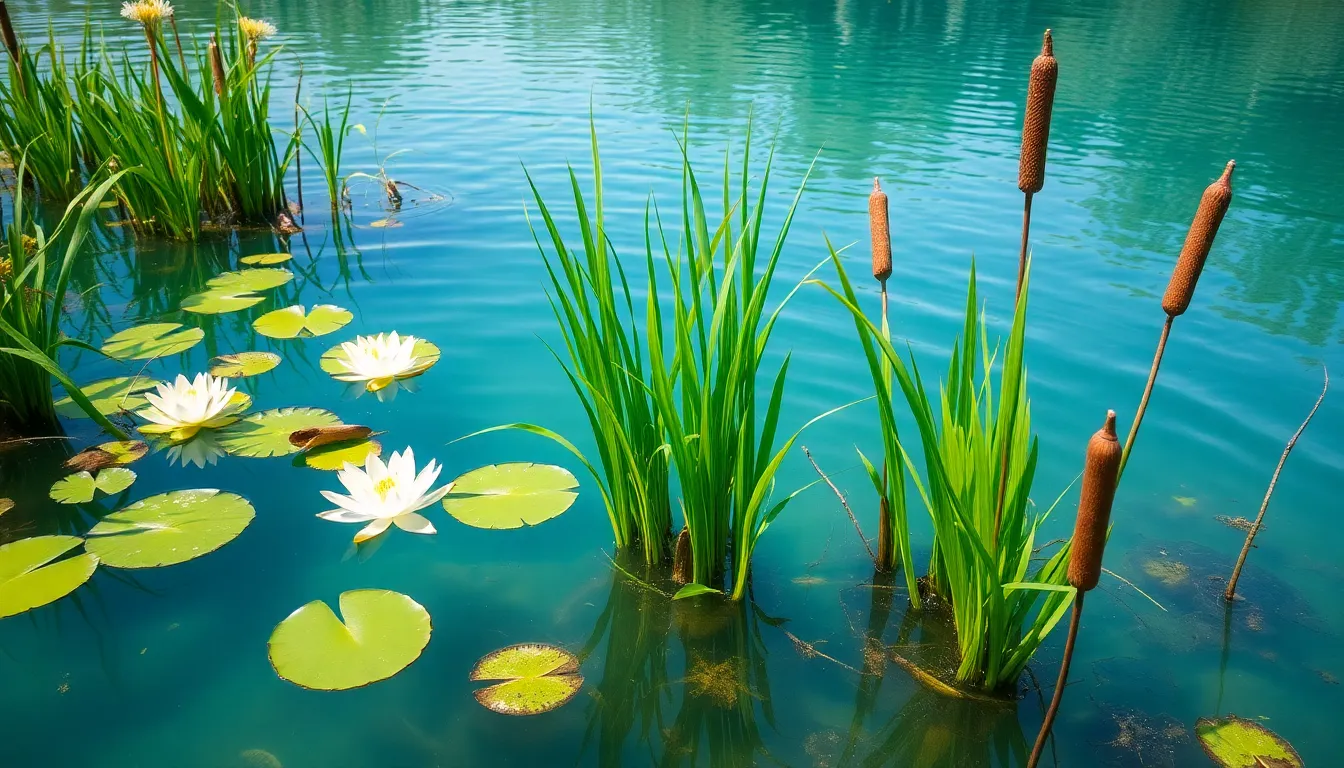Dive into the fascinating world of aquatic plants, where beauty meets functionality in the most delightful ways. These green wonders aren’t just the backdrop for your favorite fish; they’re the unsung heroes of aquatic ecosystems. From purifying water to providing shelter, they’re like the multitaskers of the underwater realm—think of them as the Swiss Army knives of the pond!
Table of Contents
ToggleOverview of Aquatic Plants
Aquatic plants thrive in water, playing a crucial role in various aquatic ecosystems. They offer diverse forms, sizes, and functions, each contributing uniquely to their habitats.
Definition and Characteristics
Aquatic plants encompass a wide range of species, including floating, emergent, and submerged varieties. Features such as specialized leaves and roots enable them to adapt to aquatic environments. Adaptations include air-filled tissues that assist in buoyancy and photosynthesis. These plants can be divided into two categories: hardy and tender, with hardy species enduring cold temperatures. Growth patterns vary, influencing their distribution in freshwater and saltwater systems.
Importance in Ecosystems
Aquatic plants significantly enhance ecosystem health and stability. They provide essential habitats for various aquatic organisms, including fish, amphibians, and invertebrates. Moreover, aquatic plants improve water quality through filtration and nutrient uptake, often reducing harmful pollutants. Photosynthesis by these plants generates oxygen, supporting aquatic life. The complex root structures prevent erosion along shorelines, maintaining ecosystem integrity.
Types of Aquatic Plants


Aquatic plants come in various types, each playing specific roles in their habitats. Understanding these categories enhances appreciation for their ecological functions.
Floating Plants
Floating plants exist on the water’s surface, providing shade and habitat for aquatic life. Examples include water lilies and duckweed. These plants possess wide, flat leaves that capture sunlight effectively, facilitating photosynthesis. They also help reduce evaporation by forming a canopy over the water. Floating plants enhance water quality by absorbing excess nutrients, thus preventing algal blooms.
Submerged Plants
Submerged plants grow entirely underwater, contributing to the ecosystem by oxygenating water and serving as nursery habitats for fish. Examples include eelgrass and hornwort. These plants exhibit long, slender leaves adapted to minimize water resistance. Submerged plants stabilize sediments, reducing turbidity levels in water bodies. They play a crucial role in providing shelter and food for diverse aquatic organisms.
Emergent Plants
Emergent plants grow partially above water, with their roots anchored in the substrate. Examples include cattails and bulrushes. These plants contribute to shoreline stabilization, preventing erosion. Emergent plants offer crucial habitats for birds and insects. Their stems and leaves provide cover, while their extensive root systems filter pollutants from the water, enhancing overall ecosystem health.
Benefits of Aquatic Plants
Aquatic plants contribute significantly to ecosystem health and human activities. Their roles extend beyond aesthetic appeal, providing critical environmental and economic advantages.
Environmental Benefits
Aquatic plants enhance water quality by acting as natural filters. They absorb harmful nutrients and pollutants, contributing to cleaner water ecosystems. These plants also produce oxygen through photosynthesis, supporting aquatic life. Habitat creation occurs as they provide shelter for fish and invertebrates. Additionally, they stabilize sediments and prevent shoreline erosion, maintaining the integrity of aquatic environments. Their presence reduces evaporation rates, which is beneficial for maintaining water levels during dry seasons.
Economic Uses
Aquatic plants hold various economic benefits for communities. They serve as a sustainable resource for craft and decorative purposes, with species like water lilies often used in floral arrangements. The food industry utilizes specific aquatic plants, offering items such as water chestnuts. Aquatic plants also support aquaculture, serving as food for fish and enhancing fishery productivity. In landscaping and gardening, these plants add beauty and biodiversity, increasing property values. Additionally, the potential for biofuel production from certain types presents a future avenue for renewable energy development.
Challenges Facing Aquatic Plants
Aquatic plants face numerous challenges, primarily arising from human activity and environmental changes. Understanding these obstacles is crucial for their preservation and the health of aquatic ecosystems.
Pollution and Habitat Loss
Pollution significantly impacts aquatic plants by introducing harmful substances into their environments. Nutrient runoff from agriculture leads to algal blooms, which block sunlight and deplete oxygen levels, harming plant life. Heavy metals and chemicals accumulate in sediments, affecting plant growth and reproduction. Habitat loss also poses a severe threat, as urban development and industrial activities destroy wetlands and waterways. Dredging and damming disrupt natural flow patterns, altering habitats that aquatic plants rely on for survival. Protecting against pollution and habitat loss requires concerted efforts from communities and policymakers alike.
Invasive Species
Invasive species threaten native aquatic plants by outcompeting them for resources. Species like water hyacinth and giant salvinia rapidly proliferate, forming dense mats that choke out native flora. These aggressive invaders can alter habitat dynamics and limit sunlight penetration. They also impact local wildlife that depends on indigenous plants for food and shelter. Controlling invasive species involves monitoring and management strategies that include physical removal, chemical treatments, and public education. Swift action can help restore balance in aquatic ecosystems and support native plant communities.



